Click To Call > (800) 966-7673

Termites are very social creatures. They work together as a team to provide food, water and shelter so their colony can reproduce and swarm off to start new colonies.
Termites feed on cellulose, which is found in plants, but they also feed on materials that contain cellulose like lumber, cotton fibers, paper, cardboard, furniture, etc.
Termite mounds are the product of the colony getting too large for the initially unseen, underground nest and the mounds grow in size with the colony concealed within. Other termites burrow into wood to find shelter and create a nest environment. One of the tell-tale signs of this is the small mud tubes they build to gain access to wood material.
Subterranean termites are the most common in North America and cause 95% of the estimated $2 billion in damage in the US each year.
Each termite colony has its own society made up of specialized levels or castes, each with a different responsibility:
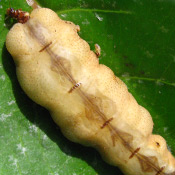
Queen (aka: Primary Reproductive)
The largest member of the colony at just under 4” long. She’s so big that if she needs to move, it requires several hundred workers pushing at once.
She creates the colony by laying eggs until enough workers and nymphs are produced to care for the colony.
She can live for more than ten years and can lay up to 30,000 eggs in a day.
King (aka: Primary Reproductive)
Assists the queen in creating and attending to the colony during its initial formation.
The king continues to mate throughout his life to help increase the colony size.
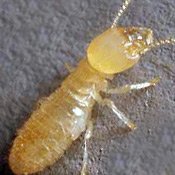
Worker Termites
Soft-bodied, light-colored with no wings, workers are about 10 mm in length (about the size of a grain of rice).
They are busy 24/7 and rarely leave the tunnels of the colony. They are responsible for caring for the eggs, constructing and maintaining tunnels, foraging for food, feeding and grooming the other members of their colony.
![]()
Soldiers
White, soft-bodied and wingless.
Soldiers have long heads with two powerful jaws which are used as weapons against predators.
They are responsible for defending the colony, primarily against invading ants.
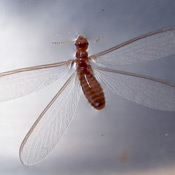
Winged Reproductives
These are both male and female termites that produce offspring for the colony.
They develop wings and leave the parent colony in a swarm to mate and start new colonies.
Colonies can have both Primary Reproductives (1 king and 1 queen) and hundreds of secondary reproductives to assist in egg laying and colony growth.
The Subterranean termite (Family Rhinotermitidae) is the type of termite most commonly found in Michigan, Ohio and Indiana
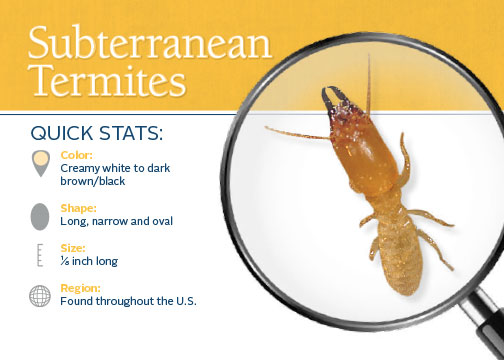
Overview:
Subterranean termite colonies are organized into castes depending on tasks – workers, soldiers and reproductives. The characteristics of a subterranean termite are dependent on the termite's role in the colony. Worker subterranean termites are ¹⁄₈ to ³⁄₈ inch long. Soldier subterranean termites are of a similar body length, but are distinguished by their powerful mandibles and large brown heads. Reproductive subterranean termites are approximately ½ inch long.
Habits:
Subterranean termites live in underground colonies or in moist secluded areas above ground. They build distinctive "mud tubes" to gain access to food sources and to protect themselves from open air. Like other termite species, they feed on products containing cellulose. Subterranean termites swarm in the spring when groups of reproductive termites go off to start new colonies.
Threats:
Subterranean termites are by far the most destructive termite species. The hard, saw-toothed jaws of termites work like shears and are able to bite off extremely small fragments of wood, one piece at a time. They can cause severe property damage.
Source: Pestworld.org
|
Flying Ant |
|
Flying Termite |
||
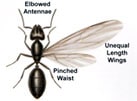 |
 |
|||
|
Wings |
Front pair is longer than the back pair. Not easily broken off. |
Front and back wings are the same size. Easily broken off. |
||
|
Waist |
Narrow and pinched. |
Thicker and less defined. |
||
|
Antennae |
Elbowed |
Straight |
Termite colonies eat non-stop, 24 hours a day, seven days a week! Sorry, no break folks!
Termite colonies can live with no problem for many generations of worker termites, which can be as long as 50-70 years.
In the USA, an average termite colony has about 500,000 insects.
Termites provide a valuable service by breaking down dead wood in forests into soil. They are one of the earth's first recyclers.
Subterranean termites MUST have constant access to water. If they dry out, they die.
Above ground, termites maintain mud tunnels or tubes to the ground, which they keep wet with water from the ground.
Termites’ main predator is the ant. Ants can attack termite colonies or termite workers looking for food.
It is possible to get rid of termites completely.
There are over 2,000 species of termites, with most living in tropical and subtropical parts of the world.
About 40 termite species live in the United States, most in the southeast.
Subterranean termites are found in every state but Alaska.
More than 90% of all termite damage in the US is caused by subterranean termites.
Termites can’t eat their way through concrete, but their soft bodies are really good at maneuvering through tiny cracks.
The total weight of all of the termites in the world is more than the weight of all the humans in the world.
Only worker termites can chew and digest cellulose. So, along with gathering food, they have to digest and regurgitate it for everyone else.
A queen termite can live over 20 years and can lay thousands of eggs a day.
Those round metal circles you see on the sidewalk in the French Quarter of New Orleans are not secret stashes for beads. They’re Sentricon station covers.
No, termites do not pose an immediate physical threat to humans as they do not bite and do not carry any diseases that can be transmitted to humans. That said however, termites can still pose an indirect threat to humans. They have a great capacity to cause untold damage to wooden structural members in properties, causing failure of those columns and beams and possibly even total collapse if the problem is not investigated and rectified.
![]()
Rose Pest Solutions recommends the Sentricon Colony Elimination System which is designed to eliminate any termite infestations you may have and protect against future termite activity. Sentricon® Termite Colony Elimination System is effective termite elimination and control. It’s proven to eliminate the colony – not just individual termites and provides environmentally safe protection 24/7 with continued service.
Due to the complex nature of investigation and treatment, do-it-yourself termite control and eradication is generally not something many people have success at. When in the wrong hands or mixed and used improperly, pesticides can be hazardous to humans, animals and plants, therefore the best answer for your termite pest problem is Rose Pest Solutions' Termite program.
Rose Pest Solutions uses the latest methods to rid you of your pests and all products we use have been tested and registered by the EPA. We follow a series of very stringent guidelines for the use of the product, as laid down by the EPA so that whatever method of control we use poses no threat to people, pets, or plants. Should any specific safety measures need to be taken, our highly trained service technicians will make sure you have a thorough understanding of them.
Source: Pestworld.org

The Rose Home Service Program offers regularly scheduled pest control services for a single annual price, designed to identify and prevent infestations of the most common pests. Whether you're dealing with ants, spiders, or other common invaders, our Home Service Programs provide year-round protection and peace of mind.